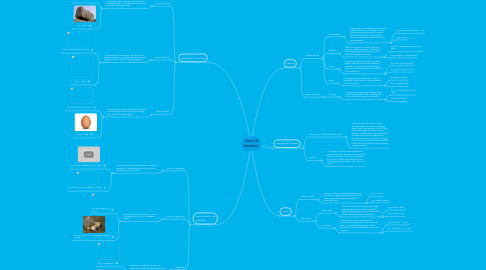
1. Types Of Structures
1.1. Solid Structures
1.1.1. A solid structure is a structure that is solid all the way through. It is mostly made of the same material all the way through.
1.1.1.1. E.g. A Hockey Puck
1.1.1.2. E.g. A Rock
1.2. Frame Structures
1.2.1. A frame structure is made up of parts that are fastened together. The pieces that are fastened together are normally thin and strong pieces.
1.2.1.1. E.g. The Skeleton Of A Human
1.2.1.2. E.g. A Chair
1.3. Shell Structures
1.3.1. A frame structure is structure that is hollow all the way through. There is a thin but strong layer around the empty spots.
1.3.1.1. E.g. The Shell Pf A Sea Crab
1.3.1.2. E.g. An Egg
2. How Forces Are Applied
2.1. Point Of Application
2.1.1. The exact location of where the force meats the structures. It is either the top of the structure, the bottom or the middle.
2.1.1.1. E.g. Where A Rocket Hit On A Tank
2.1.1.2. E.g. Where A Cannon Ball Hit A Tower
2.2. Plane Of Application
2.2.1. Side of a structure affected by a force. the angle is 90, 180 or a 45 degree angle.
2.2.1.1. E.g. The Angle Of A Punch
2.2.1.2. E.g. The Angle Of A Wrecking Ball Hitting A Tower
2.3. Magnitude
2.3.1. How heavy or light the force is. The speed of the force itself hitting the object.
2.3.1.1. E.g. An Explosion
2.3.1.2. E.g. Speed Of A Car
3. Forces
3.1. Internal Forces
3.1.1. Compression
3.1.1.1. Compression is a pushing force on parallel sides of a structure. It must be on both sides because if it's only on one side it would be only a push and move the structure and possibly topple it over, but not compress it.
3.1.1.1.1. E.g. Get Pushed Against A Wall
3.1.1.1.2. E.g. A Pinch
3.1.2. Tension
3.1.2.1. Tension is any pull on parallel sides of a sturcture. Like compression, it would only move and possibly topple the structure over if it was only on one side.
3.1.2.1.1. E.g. Get A Stuck Sword Out From A Stone
3.1.2.1.2. E.g. Dragging A Stubborn Kid
3.1.3. Torsion
3.1.3.1. Torsion is any twist on a structure. Torsion doesn't need force on parallel sides of a structure, but it may need something to hold it on one side and twist on another of the parallel sides.
3.1.3.1.1. E.g. Twist A Piece Of Clay
3.1.3.1.2. E.g. Twist A Person's Arm
3.1.4. Shear
3.1.4.1. Any bending force is classified as shear. As long as the force makes the structure bend it counts as shear.
3.1.4.1.1. E.g. Bend A Pencil
3.1.4.1.2. E.g. A Karate Chop
3.2. External Forces
3.2.1. Gravity
3.2.1.1. Gravity is the force pulling anything closer to the centre of the planet. Anything that has to do with falling would be gravity.
3.2.1.1.1. E.g. An Apple Falls From A Tree
3.2.1.1.2. E.g. Static Loads
4. Loads
4.1. Dynamic Loads
4.1.1. Dynamic loads are loads that apply force on a structure not because of gravity. It can be anything else that makes the structure experience force.
4.1.1.1. E.g. A Punch
4.1.1.2. E.g. Natural Events
4.2. Static Loads
4.2.1. Dead Loads
4.2.1.1. The structure itself. Since gravity is pulling anything within its reach, the structure is getting pulled down. The structure must be strong enough to support its weight.
4.2.1.1.1. E.g. School Locker
4.2.1.1.2. E.g. A House Itself
4.2.2. Live Loads
4.2.2.1. Live loads are loads acting force on a structure that is temporary. Unlike the dead load, it's not permanently acting on the structure, but like the dead load, it's caused by gravity.
4.2.2.1.1. E.g. People In A House
4.2.2.1.2. E.g. Backpacks In A Locker
5. Centre Of Gravity
5.1. How To Make A Structure More Stable
5.1.1. There are several of ways to make a structure stable. You can have a bigger base, have a heavier base, or both. When you have a bigger base, the centre of gravity is lowered, and it would be harder to topple over since the angle of the structure leaning to a side must be bigger for it to topple. Having a heavier base also makes the centre of gravity lower, causing to same reaction.
5.2. What It Is
5.2.1. The centre of gravity is where the gravity pulls the most. It is also where the structure has the most mass. If you drop a structure, the centre of gravity is should be as close to the ground as it could be after it turns in midair.

